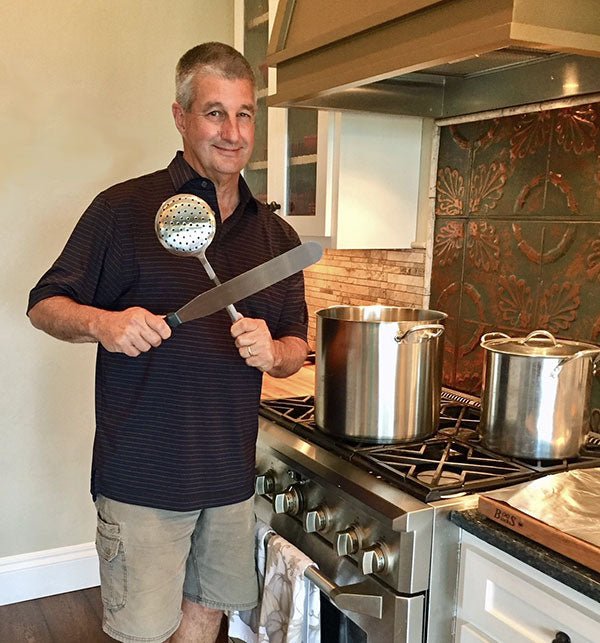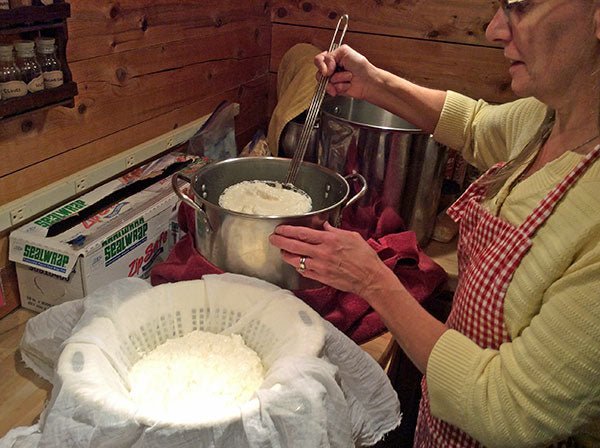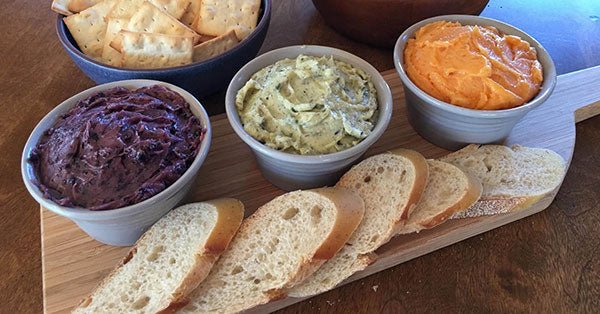
Bill Strelke considers himself to be a novice cheese maker, but we beg to differ. He has made a wide variety of very impressive looking cheeses which, unfortunately we have not been able to taste because we live thousands of miles apart. Actually, Bill himself hasn’t been able to taste many of them because he made them fairly recently and they are still aging happily in his wine cooler “cave.”


His cheese cave is a wine cooler from a local “big box” store. Unlike small refrigerators or under counter beverage coolers, it easily maintains temperatures in the 45F to 60F range.
So far, he has made English cheddar, Robiola, Colby, Hispanico, Peppa (with Jalapeño), Gouda and Mozzarella. He told us he used the recipes on our website to make all of them.

He misspelled Hispanico, then ran out of labeling tape!
Interview with Bill
You live in Fredericksburg?
Yes, in the heart of the beautiful Texas Hill Country. It is a unique area in central Texas that is known for its many large rolling hills covered in bluebonnets, beautiful valleys, ancient live oak trees, crystal clear water and an explosion of spring wild flowers.

Typical hill country landscape
The hill country is a semi-arid land of transition between the wet, lush area of east Texas and the dry desert-like landscape of west Texas. Not too many people outside of TX are familiar with our hill country (Edwards Plateau) but it is certainly worth a visit in the spring.

Spring blue bonnets
Are you from there?
I grew up in Dallas, TX and went to college at Stephen F. Austin University and graduate school at Texas A&M University. My wife and I met in college and married shortly after graduation. I worked as a medical technologist for several years and then went into medical equipment sales and later into medical sales and marketing management. Working for a large multi-national medical equipment manufacturer, we moved around the United States “a bit” and traveled to western Europe regularly.

With his wife, Rhonda on the porch of his wood working shop last winter.
Our U.S. journey started in Texas, then to Mississippi, Arkansas, back to Texas, New Jersey, Seattle, Chicago and then finally home to Texas 5 years ago. We have 3 adult children; a career Marine, an Air Force Pilot and a medical equipment sales representative, 3 grandsons with one on the way, and a German Shorthair pointer named Rex. He is 13 years old and long retired from his bird hunting days.

Rex
How and when did you first get interested in making cheese?
The “when” part of the question is easy. I became interested in making cheese about 4 years ago. The “how” part is a rather long and twisting trail…
When I was growing up, cheese was always around the house but money was tight, so we did like many others in the 50’s and 60’s; we ate processed cheese and pre-grated parmesan out of a shaker can. Consequently, cheese was not that interesting to me. Moving forward to my college days, I majored in zoology and botany sciences while working in a medical laboratory where I developed some microbiology skills… still not interested in cheese but was fortunate to be developing some knowledge that would come into play later.
I joined the corporate world in the 80’s and had the opportunity to travel on business extensively across the United States and western Europe. The cheese interest then came into play. While dining alone in a small restaurant in Rome, I noticed a gentleman across from me eating a pasta dish with a 3 or 4 oz. chunk of what I presumed was parmesan cheese on a separate plate. He did not grate it, rather he broke off rather large pieces and popped them in his mouth. What… I had never see that (sheltered life, I suppose). As soon as I returned to the US I bought a wedge of parmesan, broke off a piece, ate it and I then understood; but still not interested in making cheese.
Now, flash forward a few more years. While staying at hotel in some long forgotten place, they were having a wine tasting of sorts and were making mozzarella in the lobby. Heck, I did not know you could just make mozzarella and eat it on the spot! The fresh, warm cheese was delicious and I thought if they can do it so can I. Still no real interest in actually making cheese, but I was slowly moving in that direction.
One last flash forward was when I retired. I was fortunate enough to be able to take my wife to the Tuscany region of Italy for a retirement celebration. We did the usual visitation of wineries and shops in several small villages.

Tuscany region – showing several homes with the usual olive groves and vineyards
We went into a cheese shop in Montepulciano and a large crock with “moldy cannon balls” in it caught my attention. It was actually pecorino aging in ash. I said “if they can sell something this ugly, it must really taste great” so we bought some. When we later took a bite of the medium-hard aged cheese… well let me just say it was wonderful. NOW I am interested in making cheese.

After returning home I began reading, researching and accumulating some basic equipment from The New England Cheesemaking Supply Company. Making mozzarella was fun but I wanted to make real cheese and now I am doing just that. While I am not making pecorino, the learning process is moving along at full speed. Yes, I have already made a few mistakes in the making process, but the science and microbiology knowledge is now coming in handy. I can’t wait to move beyond some of the beginner cheeses and put my first wheel of hard cheese in the cave for 12+ months.

Are you self-taught?
Totally self taught which produces a few less than perfect outcomes. I will eventually go to a cheese workshop. It is not a $$$ thing, rather my usual approach to research – study, do it, adjust and do it again differently, and repeat until I hit a wall or stop improving the end product. I then know enough to be dangerous and I tap into all the knowledge I can from the experts in a workshop environment.

What are your goals for your cheese making?
For now my goals are pretty simple. I want to become skilled enough to have confidence making good cheese to share with family and friends. Attending a workshop of the appropriate expertise level is both a need-to-do and a goal. I would love to have 100 wheels of cheese moving through the aging process. Hmmm, what to do with all that cheese?
At some point, I have to move out of the kitchen- thus, a make-room becomes a goal along with a real cheese cave that can handle the inventory.
Lastly, I am itching to make some hard cheeses. Why? I suppose it goes back to my visits to Italy. There is much to learn before I tackle that process.

Any advice for beginners?
Being a rookie cheese maker, many things come to mind, but I will try to keep it short. Thus far, I probably have more time invested in problem solving, pondering how to overcome process issues without a commercial kitchen, deciding on and accumulating equipment, etc. than I have hours in making cheese. However, that is quickly changing.
Patience: First and foremost, have fun with cheese making. It is an adventure and the few cheeses I’ve made seemed to have their own set of unique events. Of course, “unique events” is code for problems and they require some patience but I learn more with every batch and how to adjust the next time. My colby cheese was a good example of this. The make process went great – I thought. The beautiful orange cheese came out of the cave on schedule. When we sliced the cheese for a first taste, it was drier than anticipated and slightly sharp. Next time, I will cook the curds a bit less and adjust to reduce lactic acid production. Our solution for the sharp colby; we made pimento cheese spread and it was delicious.
Milk: There are virtually no cow dairies in central Texas, so finding the right milk has been challenging and it shows in forming / not forming good curds. Several batches had to be thrown out. I cycled through multiple brands of store bought milk before finding one that worked reasonably well with a few adjustments to recipe timing. If you must use store bought milk, call the dairy and ask what their target pasteurization temperature is for the specific milk you are buying. Even the large commercial dairies will share this information. I found the information regarding milk on the New England Supply web site (cheesemaking.com) to be very helpful. I found a raw and low temperature dairy recently, but the 200 mile round trip will have to wait a little while.
Humidity control: Controlling the humidity was a challenge. After reviewing several DIY articles, I settled on the WILLHI humidity controller. When the minimum – maximum humidity is set, the controller automatically turns power on and off to the humidifier, maintaining your target range. When selecting a humidifier to match up with such a controller, be sure to find a humidifier with an on-off “switch.” The universal type on-off buttons, like on your cell phone or car radio, (push once for “on,” press again for “off”) will not work with the power device because the univeral on – off button resets to off when the power shuts off and will remain off when the power resumes. I have been happy with this set up, other than the small bottle capacity that requires refilling every day or two.
Flexibility: Working in a medical laboratory many years ago taught me to follow a procedure exactly as written – no variation. As a new cheese maker, I soon realized that the milk is a variable and cheese recipes will require some adjustment to accommodate. OK, “who moved my cheese?” As long as I follow safe food preparation practices, a little adjustment and experimentation adds some excitement, anticipating what will come out of the cave in 2 or 3 months.
Wax or natural rind: Of course, my robiola was natural rind. The mold that formed at about 3 weeks defaced my beautiful little cheeses. That is normal and safe but I am not quite ready for a daily rub down with diluted salt water. Thus, my other cheeses are waxed (dipped) and sit comfortably in their wax cocoons with no mold and little maintenance. For now, I will continue to wax when appropriate just to eliminate the mold variable and reduce maintenance chores. Your choice.
Resources: There is an astonishing amount of information on the web regarding cheese making. As a beginner, I found that the more I read from various sources the more confusing some processes became. When I settled on the New England Cheesemaking Supply Co. as my primary resource, things became easier to understand. Why? The consistency and conformity of information relating to their recipes helped me tremendously. As I learn and develop experience, additional resources will be more useful, but for now, New England Supply is my go-to. Jim “The Technical Guy” responds quickly and is a big help on specific making questions. He can be contacted on the site’s “Contact Us” page or at info@cheesemaking.com.
Other hobbies?
My interests/hobbies include wood working, tending our vegetable garden, cooking just about anything, fly fishing, kayaking, managing our property for wildlife habitat improvement by reintroducing native plant species, active in our church and an international service organization, AND OF COURSE making cheese!

Bill’s woodworking shop where his cave is located.

Last year’s fall garden. Broccoli, Swiss chard, collards, cauliflower.

Fly fishing in Alaska

Kayaking at the Devil’s River in South Texas

One of the many reasons the river is named The Devil’s River!

Ear Ring (notch in her left ear) and her twins who were born behind the shop. The fawns were only a few hours old and still having trouble gaining their balance.

Turkeys having a back yard party under their feeder.
I am convinced staying busy with with my spouse, family, hobbies, and community service is a key ingredient to a happy retirement. Thus, we are quite happy in retirement.















































































































































